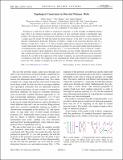Topological Constraints in Directed Polymer Melts
Author(s)
Serna, Pablo; Bunin, Guy; Nahum, Adam
DownloadPhysRevLett.115.228303.pdf (387.7Kb)
PUBLISHER_POLICY
Publisher Policy
Article is made available in accordance with the publisher's policy and may be subject to US copyright law. Please refer to the publisher's site for terms of use.
Terms of use
Metadata
Show full item recordAbstract
Polymers in a melt may be subject to topological constraints, as in the example of unlinked polymer rings. How to do statistical mechanics in the presence of such constraints remains a fundamental open problem. We study the effect of topological constraints on a melt of directed polymers, using simulations of a simple quasi-2D model. We find that fixing the global topology of the melt to be trivial changes the polymer conformations drastically. Polymers of length L wander in the transverse direction only by a distance of order (lnL)[superscript ζ] with ζ≃1.5. This is strongly suppressed in comparison with the Brownian L[superscript 1/2] scaling which holds in the absence of the topological constraint. It is also much smaller than the predictions of standard heuristic approaches—in particular the L[superscript 1/4] of a mean-field-like “array of obstacles” model—so our results present a sharp challenge to theory. Dynamics are also strongly affected by the constraints, and a tagged monomer in an infinite system performs logarithmically slow subdiffusion in the transverse direction. To cast light on the suppression of the strands’ wandering, we analyze the topological complexity of subregions of the melt: the complexity is also logarithmically small, and is related to the wandering by a power law. We comment on insights the results give for 3D melts, directed and nondirected.
Date issued
2015-11Department
Massachusetts Institute of Technology. Department of PhysicsJournal
Physical Review Letters
Publisher
American Physical Society
Citation
Serna, Pablo, Guy Bunin, and Adam Nahum. “Topological Constraints in Directed Polymer Melts.” Physical Review Letters 115, no. 22 (November 2015). © 2015 American Physical Society
Version: Final published version
ISSN
0031-9007
1079-7114